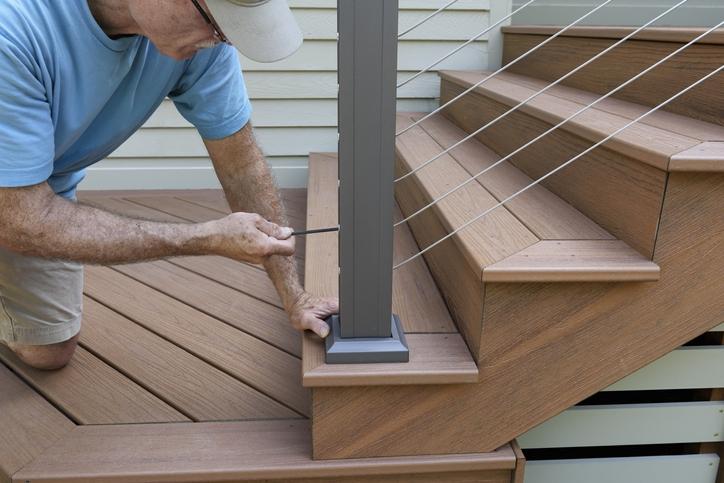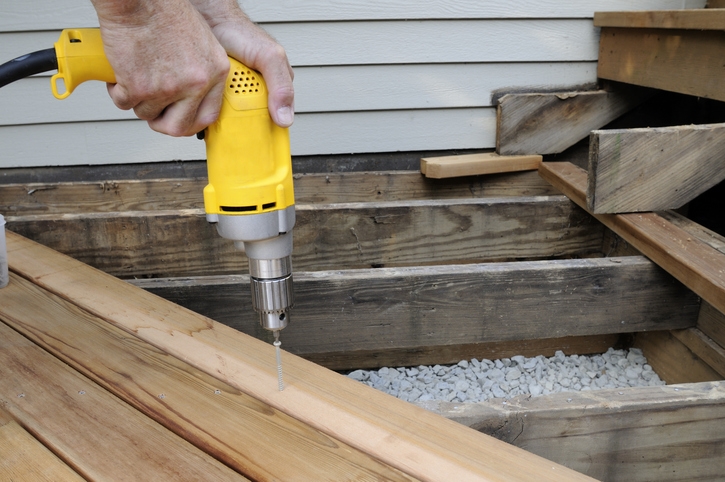An exterior stair railing code is a regional guideline. It can be difficult enough to remember everything that needs done around the house without having to think about the laws. But it is something that needs to be taken into account.

The law doesn’t become relevant but it is best to keep it that way. You can do that by making sure that everything in your home or business, is up to code. For example, your stair railing.
You are watching: Is There An Exterior Stair Railing Code?
The rules for interior stair railing aren’t very strict and are not often monitored. But those for exterior stair railing can get in your way if a neighbor reports an unsafe exterior stair handrail. So let’s prevent that from happening.
Why Does The Exterior Stair Railing Code Exist?
Your first thought may be, “why does it matter what I do with my handrails?” The answer isn’t as simple as the question though. There are a few reasons that there are laws and codes in place regarding handrails.
Exterior stair railing codes are in place for your safety, of course, but also for the safety of others. Not to mention, the codes are intact so that the chances of the state having another emergency room visit are lessened.
So everything comes around, but when it comes to private homes, things are more lenient. You can get by with more. But in public spaces, the codes are strict and there isn’t any room for taking chances.
Exterior Stair Railing Code

Your local government’s building regulations dictate which codes are in place near you. But when it comes to the standard regulations, there are three primary organizations that take care of things.
These three organizations are the International Building Code, the International Residential Code and the Americans with Disabilities Act of 1990 set the standard for building regulations in the United States.
Exterior Stair Railing Code: Rail Height
The first rule in place says that stairs that must be crossed on your way in and out of the building must have handrails. These rails must be between 34 and 38 inches above the floor or steps, which is a generous range.
Although you can get by with anything above 30-inches, it is better to stick to around 36-inches. This is a more comfortable height for most people anyway so it will be natural for you.
Exterior Stair Railing Code: Rail Load

The rails also must be able to support a load of at least 200 pounds. Though this may not cover anyone, it will cover the weight put on the rail as you won’t use your full weight when leaning on a handrail.
It is always better to add extra support but there isn’t an easy way to test how much the railing can support before you install them. So this is a good time to hire a professional or get a railing kit to make things easier.
Exterior Stair Railing Code: Rail
Handrails must extend a minimum of 12 inches past the riser of the top step. This gives enough space for someone to grab onto the rail before they start walking down the stairs. Without it, the railing would be useless.
Read more : The Best Outdoor Security Cameras of 2023
Because most people fall near the top of the stairs rather than in the middle. So make sure that the handrail extends above and below. This way, people have something to hold onto before they get on the stairs and after they step off.
Exterior Stair Railing Code: Deck Height
To be fair, a railing is not always mandatory. If you have two or fewer risers or steps on your deck, then you can get by without railing. But if you have more than two, then you need to have a railing for safety reasons.
This ends up being about 16-inches or so. So if you build a deck out of 12-inch boards, you can use them as a guide. This will give you room for a few inches below the board on the side of the deck.
Is There An Interior Stair Handrail Code?
When it comes to stair railing codes on the inside of your home, the rules are different. Most of the time, codes won’t be enforced unless the home is a duplex or condo. However, there are guidelines.
These include the standard 34 to 38-inch handrails. However, you don’t need to add them unless you have four or more risers rather than the standard two for the exterior stairs. That is the primary difference.
Exterior Stair Railing Types

Because stair railing designs are more about personal preference, we are going to talk about different materials used for stair railings. These can work both indoors or outdoors, around decks and on the stairs.
Wood
Wood is by far the most popular type of railing both indoors and outdoors. It can have a treatment to go outdoors and comes in almost any wood color or grain. The railing can also be stained or painted after being built.
The best thing about wood is that it is the most versatile option. You can make wood look like just about anything you can imagine. It isn’t as strong as metal but it is strong enough to last a lifetime.
There aren’t many problems with wood unless you want something super unique. Because even the fanciest wood railing can look traditional compared to something more modern or eclectic in comparison.
Steel
Steel is a popular material for handrails and is often used in public spaces. It isn’t quite as common for private homes but it can add an eclectic, exotic, or modern look to any type of stairwell, even outdoors.
Steel used outdoors needs to be galvanized but if you are buying the rails pre-built then it will already be galvanized to protect it from the elements and corrosion. There are many reasons to use steel railing.
Steel is very durable and safe to use. Not only is the material strong but it also has a strong hold and requires little maintenance. The problem lies with the heat and the lack of versatility that steel has.
Glass

Yes, glass is fragile and that’s the most obvious con to having a glass railing. Not only can it break but if it does break, it can also cut someone. So the material itself isn’t safe, but it can be made to be safe.
Read more : 15 Best Outdoor Wi-Fi Extenders For Long-Range Access In 2023
The most common way to use a glass railing is to use it as windows or panels on the metal or wood railing. The combo makes the glass safer and it won’t have to be load-bearing as it would if used for handrails.
What people like about glass is how clean it can look, how modern it can be, and how airy it will make a room look. The absence of open space doesn’t mean you can’t fake it with something like glass.
Iron
Wrought iron railing in particular is one of the oldest types of railings. Because it is easy to form when it is hot it is a popular choice for those who want a decorative touch. Not to mention, iron is very strong.
Today, it isn’t as popular as it was in the 1700s and 1800s because there are more common and easily-found choices. However, it is very popular for historic buildings and can be very alluring in the right design.
Though most older iron is rough, it can be smooth to have a sleek and shiny appearance. This isn’t often done with iron railing but both options leave you with an attractive railing.
Picket
So, picket isn’t a material, but most picket railing is made with easy to install and affordable aluminum. It comes in kits that you can put together yourself and looks similar to upside-down gutters.
This may not sound very cute but in the end, it is still a solid choice, if you want the railing for safety reasons only and don’t care too much about what it looks like. It is a great choice for public spaces.
The only problem with the visual is that it looks common and traditional. Though not traditional like a picket fence made of wood, it looks like railing you’d see at any balcony on any hotel in town.
Cable
Cable railing looks quite modern but it isn’t for everyone. Although it gives you more open space, it can feel cold. The metal is thin and feels like it belongs, well, on a cable line.
It can be tasteful, though, if done right. However, it isn’t very versatile. Because it does offer a lot of open space, you can distract from it with a nice frame for the cable on your railing.
That, and some good patio furniture can make it almost disappear while still helping you stay up to date on rules and regulations. This can give you more time to focus on making your porch or patio look amazing.
Making Your Final Decisions On Exterior Stair Railing Code
Choosing a deck material only matters if the material affects the safety of the railing. When it comes to codes, you can use just about any material that you want, as long as the railing follows those codes.
So get creative or keep it traditional. If someone is going to be making sure that your exterior handrails are up to code you might as well give them some nice handrails to look at. Don’t be afraid to show them off!
Source: https://gardencourte.com
Categories: Outdoor


